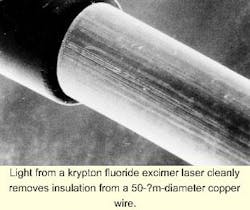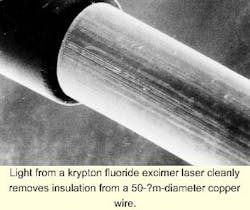Lasers strip wire precisely and without damage
A glance inside a personal computer, cellular phone, or other electronics item built around circuit boards would seem to indicate that the ordinary electrical wire has gone the way of the horse-drawn carriage. A second look, however, reveals ribbon cables linked to peripheral devices, strands running to power supplies and transducers, and other connections too numerous to list. Modern electronic devices-as well as the communications systems that link them-are laced with wire. Ranging from massive conductors that route local-area-network data within microwave communications systems to tiny whiskers that carry information to and from the read-write head of a hard disk, wires are indispensable for moving signal and power about.
In today`s precise manufacturing environments, the ability to strip insulation from wire without damage to the conductor is becoming evermore important. Laser-based wire strippers accomplish this simply, by relying on the ability of light to selectively remove nonmetallic materials while leaving copper intact.
Blades need constant monitoring
The traditional method of wire stripping calls for a shaped metal blade to be applied to a wire to sever its insulation, which can then be slid off. Although modern blade-stripping equipment includes automatic wire handling and precise blade control, it shares one thing with a home electrician`s hand wire stripper-they both need close watching to avoid wire damage.
null
In 1976, researchers from NASA (Washington, DC) and Martin Marietta Corp. (Bethesda, MD) leapfrogged the blade problem by developing the first laser wire stripper. They compared the effects of a carbon dioxide (CO2) laser on an insulated wire with those of a Nd:YAG laser and found that the CO2 laser was the clear choice. "For a CO2 laser (emitting at 10.6 µm), insulation has a low damage threshold, while copper has a high threshold," says Richard Miller, president of RtMc Inc. (Phoenix, AZ), a maker of laser wire-stripping equipment. "It`s the reverse for the Nd:YAG laser, which emits at 1.06 µm," he adds, noting that Teflon insulation in particular is transparent to Nd:YAG laser radiation.
Most industrial wire stripping is still done using blade strippers, Miller says. But, although laser wire stripping is currently a small market, it is growing at a rate much higher than the market for wire-stripping equipment as a whole, he adds. Blade stripping is generally faster and less expensive; it is when quality is all-important that laser wire stripping comes into its own.
Depending on the application, Miller explains, many manufacturers have traditionally accepted a certain amount of damage to their wires from blade stripping. For example, the tolerance on a wire`s electrical resistance can be made loose enough so that changes caused by nicks or other damage to the metal resulting from insulation removal fall within the wire`s specifications. For a multistrand cord, even breakage is sometimes acceptable-if 15 out of 19 strands in a cord survive, for instance, then it may still be usable for certain loosely toleranced applications.
null
But as electronics become more sophisticated, room for manufacturing error decreases. Along with tighter electrical specifications, manufacturers have an increasing need for wires that have consistently high mechanical strength, so that wire handling during component assembly-and sometimes later, by the user of the finished product-does not result in breakage and failure. This requirement is especially true for medical and aerospace applications. "Anywhere life is at stake, laser wire stripping is very desirable," says Miller, who mentions product liability as just one of the forces driving the trend to laser wire stripping.
Lasers cut sections from insulation
A partial list of insulation types strippable by RtMc CO2-laser-based equipment includes rubber, fabric, Teflon, polyvinyl chloride, Kapton, and fiberglass, according to Miller. The list of strippable wire types is at least as long: together with standard single- and multiconductor wires, more-complex wire configurations can be processed, including twin lead, zip cord, coaxial, twisted pair, and ribbon cable. In addition to stripping the ends of wires, the laser strippers made by RtMc can remove insulation sections of any length along the wire with a technique called "window stripping" (see Fig. 1). The equipment handles wire of diameters ranging from less than 0.001 to 1 in.
As explained by Miller, laser wire strippers are used either as stand-alone equipment-where wire is batch-loaded by hand-or as part of an integrated setup in which wire is fed automatically through the stripper from a reel. Because laser light can interact with organic material to produce noxious gases and particles, there must be airflow to carry contaminants away.
null
William Lawson, technical director of Laser Machining Inc. (LMI; Somerset, WI) describes four different opto mechanical beam-delivery systems used in the laser wire strippers produced by LMI. "The simplest technique from a laser standpoint is to rotate the wire under a stationary beam," he says. "This system is best for long lengthwise cuts" used, for example, in removing sections from the center of a wire. Using this technique, and with careful control of beam power and motion, the LMI stripper can remove only the outer sheath from doubly insulated shielded wire. A second technique, patented by LMI, involves reflecting and reimaging the beam focus to create two adjacent cutting points. In a third technique, the beam is split and focused on opposite sides of the wire, while in a fourth-suitable only for end-stripping-a beam-delivery assembly rotates about the end of the wire (see Fig. 2).
"In general," says Lawson, "there is no one laser wire-stripping technique that is best for any application. Lasers must also be compared with other wire-stripping techniques. Each application must be evaluated for speed, cut quality, reliability, initial investment, and operating cost."
Excimer laser finds its niche
Richard Miller notes that, although laser wire stripping has found a virtually perfect source in the CO2 laser, there is one application where it is found wanting. "For very fine wires with enamel insulation, the excimer laser is the way to go," he says.
Heinrich Endert, international marketing manager at Lambda Physik Inc. (Fort Lauderdale, FL), a maker of excimer lasers, concurs. "If wires are smaller than 100 µm in diameter, then excimers strip more easily and accurately," he says. A prime application for an excimer-laser-based stripper is the enameled wiring-50 to 80 µm in diameter-that attaches to hard-disk read-write heads (see photo on p. 109). Wiring that is gold-plated to enable ultrasonic bonding can be stripped by excimer-laser light without damage to the extremely thin gold layer.
A standard mask-projection technique is used to remove insulation with an excimer laser. At 248 nm, the wavelength of light from a krypton fluoride excimer laser is short enough to cause dissociation of chemical bonds and thus ablation of organic material. When fluence exceeds a threshold value, material is removed in what resembles an explosive evaporation. The process is nonthermal and can remove material to micron-scale resolution.

